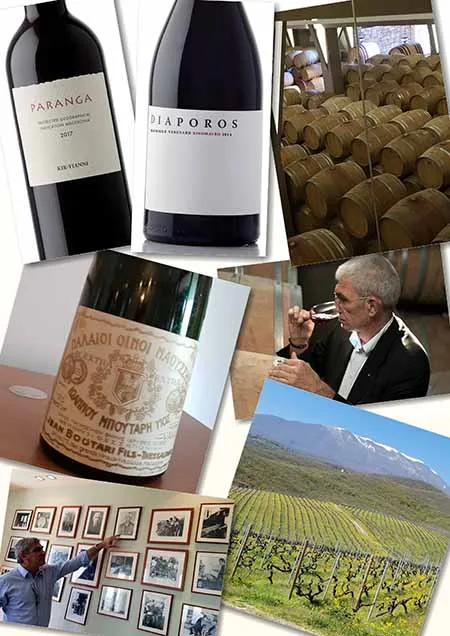Greek wine is now showing itself in Israel for the first time. A few Greek restaurants have opened and good relations between the countries means that Greece has become a must go to country for Israeli tourists. Even Maia Winery, a small boutique winery in Israel, has employed one of Greece’s most famous sons, Yannis Paraskevopoulos of Gaia Winery as their wine consultant. In other words, Greek Israeli wine relations are warming up!
The main Greek white wine varieties are the Assyrtico, Malagousia, Moschofilero and Roditis. The dominant reds are Agiorgitiko and Xinomavro. It is a whole new world for those tired of Cabernet, Merlot, Sauvignon Blanc and Chardonnay!
The variety that is leading the way in advancing Greek wine world wide is the minerally Assyrtico from the volcanic Island of Santorini, and in Israel is no different. Wines made from Assyrtico, from Gaia and Arghyros wineries, have already reached Israel, but this is only the beginning and others are sure to follow. If the object is to show Greek wine at its best, the partner red variety to Assyrtico is the Xinomavro grape, which thrives in the Nauossa region of northern Greece.
The town of Naoussa lies in the eastern foothills of the snow-covered Mount Vermio, at altitudes up to 400 meters above sea level. It lies in central Macedonia in the north of Greece. Soils are a mixture of limestone, loam, sand and clay. It is a rarity in today’s global world, an appellation devoted to one variety: the edgy and fascinating Xinomavro.
A Xinomavro can be pale, almost tawny in color, without ‘that in your face’ primary fruit. There are usually delicate red fruit aromas like strawberry and cherry, but aromas tend to be more savory than sweet. Flavors include sun dried tomato, a touch of olive and a certain wild, gamey character. The wine will be high in acidity and low in tannin and it is without doubt Greece’s most age worthy red wine, gaining complexity with bottle age. Yet modern wine making techniques and different clones offer the opportunity to make many different styles of Xinomavro, but even in lighter styles, the restrained fruit and pronounced acidity is ever present. The word Xino – Mavro gives a clue……..it translates to acid black. Many describe Xinomavro as a Greek Pinot Noir. It can certainly have some of the perfume of an aged Burgundian Pinot, but is probably more like a Nebbiolo, the grape of Barolo…..and better value than both.
The family that made Naoussa their home are the Boutaris. In 1879, Yiannis Boutaris founded Boutari Winery in Naoussa, and began arguably Greece’s most important wine dynasty. He was a merchant of wine and Tsipouro, a Greek Grappa. In 1906 he built the Zafiraki Street winery in Naoussa and moved his head office to Thessaloniki. Their existence encouraged growers to plant vineyards and they were one of the wineries that were crucial in the development of a modern Greek wine industry. As far Xinomavro is concerned, their Boutari Grand Reserve remains one of the standards of this variety. Boutari Winery have been great ambassadors for the Naoussa region and Xinomavro wines.
From the late 1960’s, the Boutari Winery was managed by the fourth generation of the family, the two brothers Konstantine and Yiannis. In the 1970s Greece started to promote wines as part of recognizing and reviving its culture. Yiannis junior instinctively understood wine was a product of a person and place and this was where the future lay. His first move was to go against company policy and plant a vineyard on a high hill in Yiannakohori. A prophet is not worshipped in his own home. His father snapped ‘we are wine sellers not wine growers’, but Yiannis persevered.
Yiannis started planting vineyards and encouraged the large monopoly company to regionalize, by opening a series of small wineries close to local vineyards. He even encouraged growers to become boutique wineries using their own grapes. This policy was against the interests of the parochial, conservative family winery, but massively in the interest of the development of Greek wine. He also developed the concept of a wine route to encourage tourism. The Wine Roads of Northern Greece is the perfect opportunity for wine tourists seeking to travel in the area.
Eventually Konstantine Boutaris the sales orientated brother and Yiannis the winemaking artist could no longer work together. In a similar schism to the Mondavi family in California, Yiannis the fourth generation, upped and left, leaving behind his heritage and inheritance, to become a boutique winery pioneer. His only request was to take a vineyard. He took the precious Yiannakohori vineyard he had planted, and founded the small, quality and terroir driven winery called Ktima Kir-Yianni (Ktima means Domaine or Chateau). This was in 1997 and it symbolized the boutique revolution in Greece and galvanized other small wineries to take up artisan winemaking.
Part of the Yiannis Boutaris scheme was to focus on Xinomavro, identifying and preserving the best clones and the making the finest, most unique Greek wine possible. Kir-Yianni returned winemaking to the vineyard. The country’s best experts studied rootstocks, clones, trellising methods, vineyard aspect and planting density. Soils were analyzed and divided into parcels. Each parcel is today cultivated separately according to its own needs. Kir-Yianni after 20 years is still at the forefront of viticultural and oenological research.
When the mercurial Yiannis Boutaris stepped down, and went into politics, his eldest son Stelios Boutaris then took over the winery. He is charismatic, good looking with a hearty laugh. He has turned a unique winery into a business with style, flair whilst maintaining loyalty to the winery’s roots. He is assisted by his brother Mihalis Boutaris, who studied winemaking at UC Davis.
The Ktima Kir-Yianni Yianakohori Hills 2015 is a well balanced blend of Xinomavro, Merlot & Syrah. This shows how well the angular, sharp features of Xinomavro blend well with softer, fruitier international varieties. The wine has great fruit, complexity on the palate and a well-balanced finish.
For those wanting the unadulterated, authentic Xinomavro taste, Kir-Yianni Ramnista Xinomavro 2015 has great structure, good complexity and is the perfect food wine. It is made 100% from Xinomavro. However the finest expression is the Diaporos, the winery’s flagship wine from block 5, within a single vineyard. It has a touch of Syrah in the blend to soften the mid palate, but it is mainly Xinomavro. This is certainly a wine that needs aging. The iron fist is slightly more dominant than the velvet glove, but it will soften over time. The aromas are tantalizing now and the class of this wine and the potential will be clear to all that have the opportunity to taste it.
Today there are other wineries producing fine Xinomavros in Macedonia, but the kings of the variety remains the Boutaris family. If wine really is a combination of a variety, person and place, then Xinomavro, the Kir-Yianni Boutaris and Naoussa appellation together result in arguably the finest expression of this quality variety. Worth exploring.
Adam Montefiore has been advancing Israeli wines for over 30 years and is known as the ‘ambassador of Israeli wines.’ He is the wine writer for the Jerusalem Post. www.adammontefiore.com



















